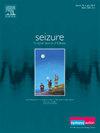Electroencephalogram microstate analysis in temporal lobe epilepsy: A comparative study with and without anxiety
IF 2.7
3区 医学
Q2 CLINICAL NEUROLOGY
引用次数: 0
Abstract
Background
Anxiety is a prevalent psychiatric comorbidity in temporal lobe epilepsy (TLE), however, limited attention has been given to the dynamic characteristics of TLE coexisting with anxiety.The aim of this study was to examine abnormal resting-state Electroencephalography (EEG) microstate dynamics in TLE patients with anxiety disorders compared with TLE patients without anxiety disorders and healthy controls.
Methods
Ninety participants in this study: 30 healthy controls (HC), 30 TLE patients with anxiety (PAS), and 30 TLE patients without anxiety (nPAS). The dynamic changes in the entire brain were detected using a 21-channel EEG for microstate analysis. This study comprehensively compared the mean duration, frequency of occurrence, time coverage, and transition probability of each microstate(A, B, C, D) among the three groups. Rigorous statistical methods were employed to ensure the robustness and validity of the research findings.
Results
The results of EEG microstate analysis revealed that the occurrence frequency and time coverage of microstate B (visual network) in the PAS were significantly reduced compared to the nPAS. Compared to HC and nPAS groups, patients with PAS exhibited alterations in the probability of EEG microstate transitions: an increase in transitions from the microstate C (salience network) to the microstate A (auditory network), a decrease in transitions from the dorsal microstate C (salience network) and microstate D (attention network) to the microstate B (visual network). These changes suggest heightened overall network alertness, impaired attention-visual pathway function, and decreased stability of the attention network.
Conclusion
Our research reveals that anxiety disorders in individuals with temporal lobe epilepsy are characterized by heightened alertness, impaired attention-visual integration, and instability of the dorsal attention network. This highlights the significant impact of anxiety on brain network remodeling and cognitive control deficits. Changes in EEG microstate dynamics may serve as a novel biomarker for psychiatric complications associated with epilepsy.
颞叶癫痫的脑电图微观状态分析:有和无焦虑的比较研究
背景焦虑是颞叶癫痫(TLE)常见的精神合并症,但对颞叶癫痫与焦虑共存的动态特征关注有限。本研究的目的是比较有焦虑障碍的TLE患者与无焦虑障碍的TLE患者和健康对照者的静息状态脑电图(EEG)微状态动力学的异常。方法90例受试者:30例健康对照(HC)、30例伴焦虑的TLE患者(PAS)和30例无焦虑的TLE患者(nPAS)。采用21通道脑电图对全脑动态变化进行微态分析。本研究综合比较了三组各微状态(A、B、C、D)的平均持续时间、发生频率、时间覆盖、转移概率。采用严格的统计方法,确保研究结果的稳健性和有效性。结果脑电微状态分析结果显示,视觉网络(视觉网络)微状态B在PAS区出现的频率和时间覆盖率均明显低于nPAS区。与HC和nPAS组相比,PAS患者的脑电图微状态转换概率发生了变化:从微状态C(突出网络)到微状态A(听觉网络)的转换增加,从背侧微状态C(突出网络)和微状态D(注意网络)到微状态B(视觉网络)的转换减少。这些变化表明整体网络警觉性提高,注意-视觉通路功能受损,注意网络稳定性下降。结论颞叶癫痫患者的焦虑障碍表现为警觉性增高、注意-视觉整合障碍和背侧注意网络不稳定。这突出了焦虑对大脑网络重塑和认知控制缺陷的重要影响。脑电图微态动力学的变化可能作为癫痫相关精神并发症的一种新的生物标志物。
本文章由计算机程序翻译,如有差异,请以英文原文为准。
求助全文
约1分钟内获得全文
求助全文
来源期刊

Seizure-European Journal of Epilepsy
医学-临床神经学
CiteScore
5.60
自引率
6.70%
发文量
231
审稿时长
34 days
期刊介绍:
Seizure - European Journal of Epilepsy is an international journal owned by Epilepsy Action (the largest member led epilepsy organisation in the UK). It provides a forum for papers on all topics related to epilepsy and seizure disorders.
 求助内容:
求助内容: 应助结果提醒方式:
应助结果提醒方式:


